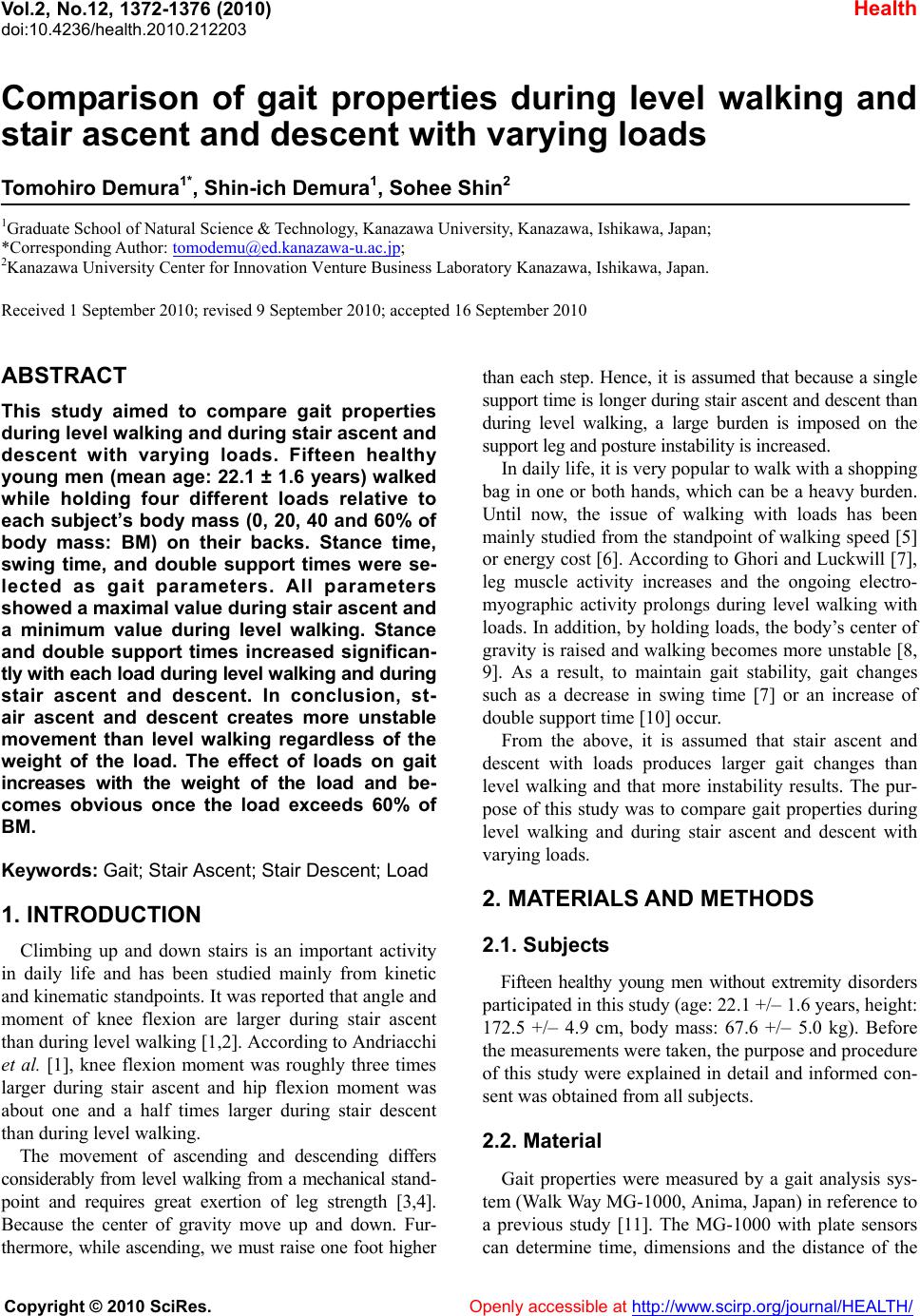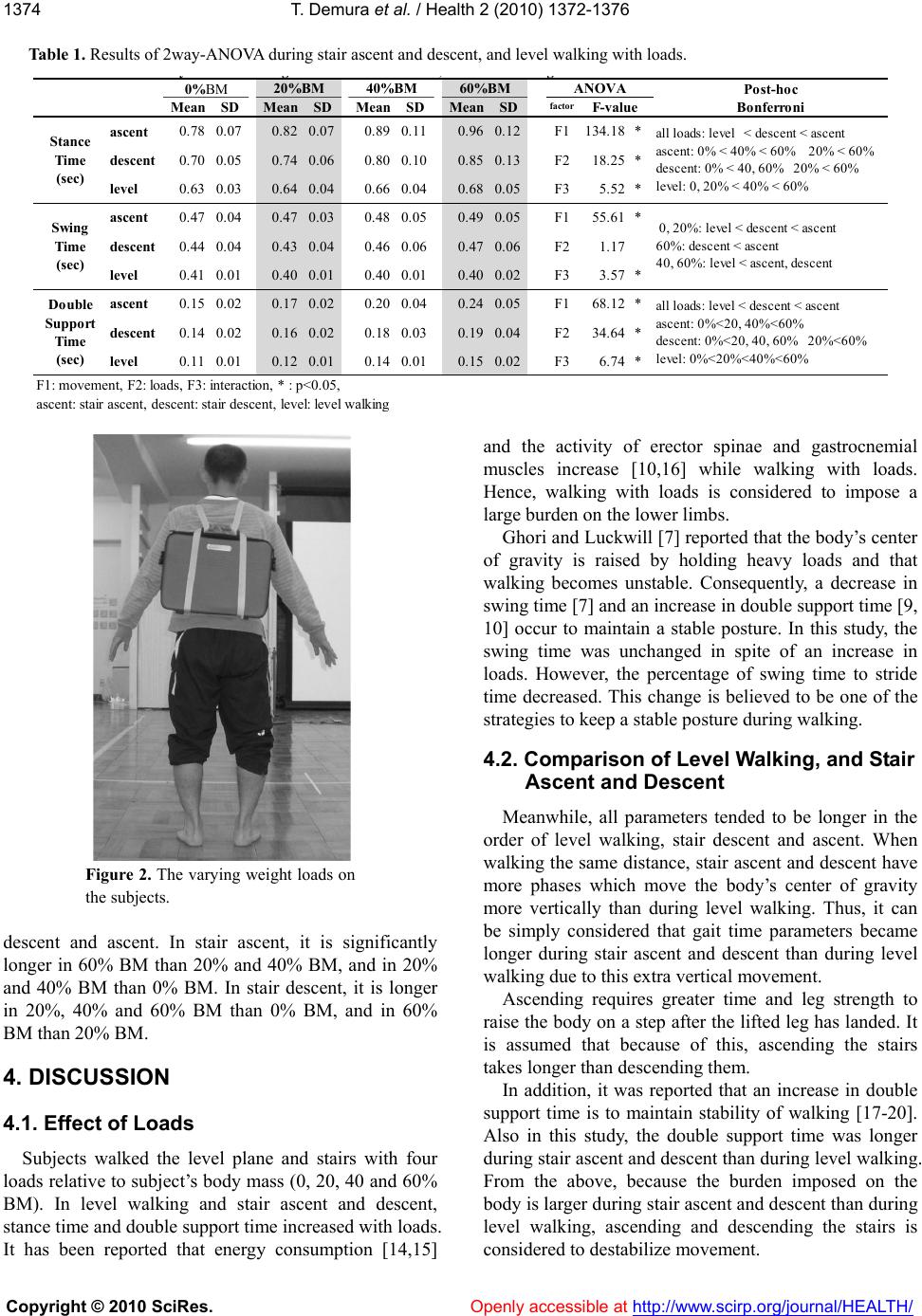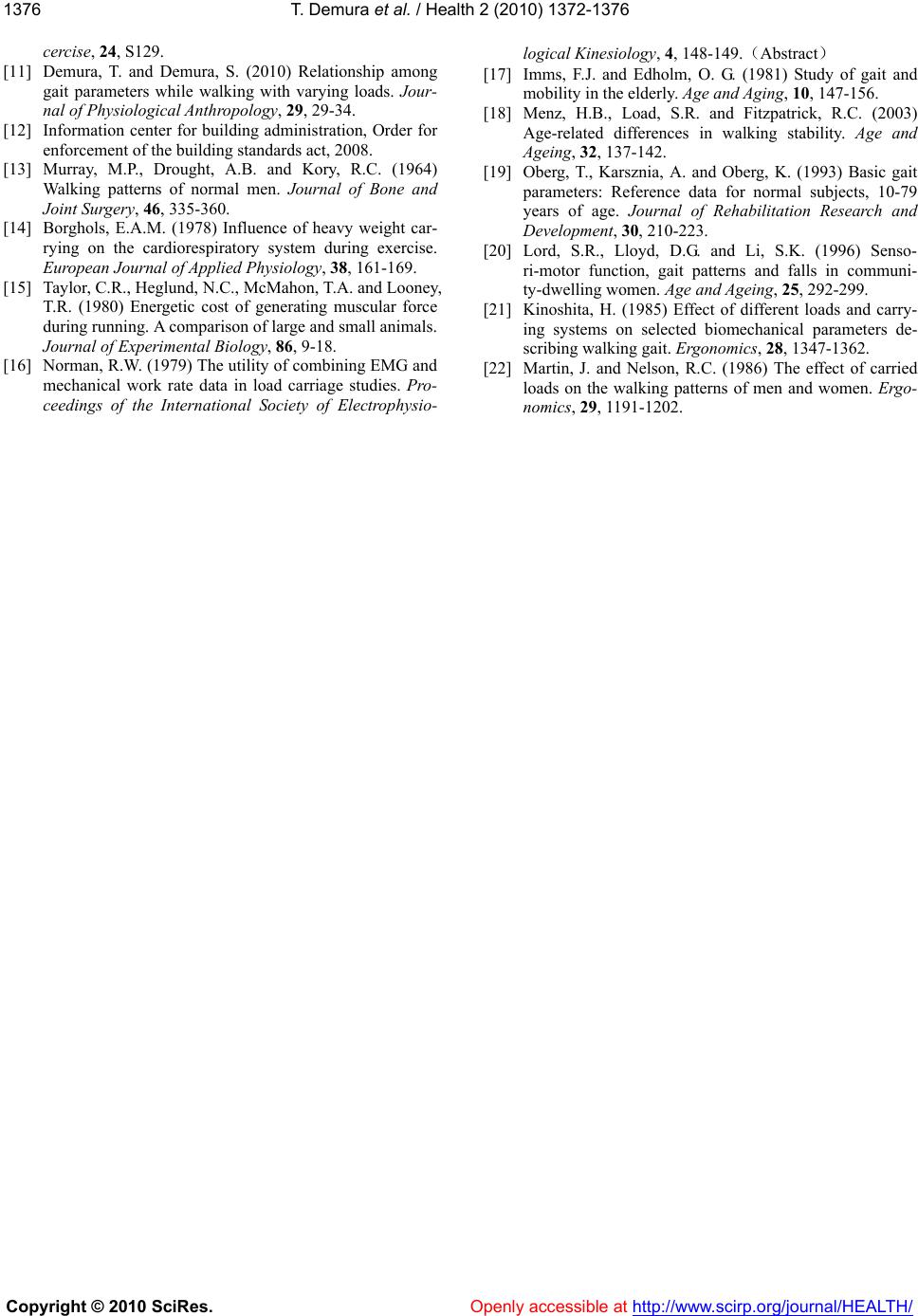Paper Menu >>
Journal Menu >>
 Vol.2, No.12, 1372-1376 (2010) Health doi:10.4236/health.2010.212203 Copyright © 2010 SciRes. Openly accessible at http://www.scirp.org/journal/HEALTH/ Comparison of gait properties during level walking and stair ascent and des cen t wi th v ary ing loa ds Tomohiro Demura1*, Shin-ich Demura1, Sohee Shin2 1Graduate School of Natural Science & Technology, Kanazawa University, Kanazawa, Ishikawa, Japan; *Corresponding Author: tomodemu@ed.kanazawa - u.ac.jp; 2Kanazawa University Center for Innovation Venture Business Laboratory Kanazawa, Ishikawa, Japan. Received 1 September 2010; revised 9 September 2010; accepted 16 September 2010 ABSTRACT This study aimed to compare gait properties during level walking and during stair ascent and descent with varying loads. Fifteen healthy young men (mean age: 22.1 ± 1.6 years) walked while holding four different loads relative to each subject’s body mass (0, 20, 40 and 60% of body mass: BM) on their backs. Stance time, swing time, and double support times were se- lected as gait parameters. All parameters showed a maximal value during stair ascen t a nd a minimum value during level walking. Stance and double support times increased significan- tly with each load during level walking and during stair ascent and descent. In conclusion, st- air ascent and descent creates more unstable movement than level walking regardless of the weight of the load. The effect of loads on gait increases with the weight of the load and be- comes obvious once the load exceeds 60% of BM. Keywords: Gait; Stair Ascent; Stair Descent; Load 1. INTRODUCTION Climbing up and down stairs is an important activity in daily life and has been studied mainly from kinetic and kinematic standpoints. I t was reported that angle and moment of knee flexion are larger during stair ascent than during level walking [1,2]. According to Andriacchi et al. [1], knee flexion moment was roughly three times larger during stair ascent and hip flexion moment was about one and a half times larger during stair descent than during level walking. The movement of ascending and descending differs considerably from level walking from a mechanical stand- point and requires great exertion of leg strength [3,4]. Because the center of gravity move up and down. Fur- thermore, while ascending, we must raise one foot higher than each step. Hence, it is assumed that because a single support time is longer during stair ascent and descent than during level walking, a large burden is imposed on the support leg and posture instability is increased. In daily life, it is very popular to walk with a shopping bag in one or both hands, which can be a heavy burden. Until now, the issue of walking with loads has been mainly studied from the standpoint of walking speed [5] or energy cost [6]. According to Ghori and Luckwill [7 ], leg muscle activity increases and the ongoing electro- myographic activity prolongs during level walking with loads. In add ition, by holding loads, the body’s center of gravity is raised and walking becomes more unstable [8, 9]. As a result, to maintain gait stability, gait changes such as a decrease in swing time [7] or an increase of double support time [10] occur. From the above, it is assumed that stair ascent and descent with loads produces larger gait changes than level walking and that more instability results. The pur- pose of this study was to compare gait properties during level walking and during stair ascent and descent with varying loads. 2. MATERIALS AND METHODS 2.1. Subjects Fifteen healthy young men without extremity disorders participated in this study (age : 22.1 +/– 1.6 years, height: 172.5 +/– 4.9 cm, body mass: 67.6 +/– 5.0 kg). Before the measurements were taken, the purpose and procedure of this study were explained in detail and informed con- sent was obtained from all subjects. 2.2. Material Gait properties were measured by a gait analysis sys- tem (Walk Way MG-1000, Anima, Japan) in r eference to a previous study [11]. The MG-1000 with plate sensors can determine time, dimensions and the distance of the  T. Demura et al. / Health 2 (2010) 1372-1376 Copyright © 2010 SciRes. Openly accessible at http://www.scirp.org/journal/HEALTH/ 1373 foot or feet when the foot touches its surface and can measure grounding/non-grounding on the bearing sur- face as an on/off signal. Data were recorded into a per- sonal computer at 100 Hz. The stairs used for the present experiment consisted of four steps (step width: 90 cm, step height: 20 cm, tread length: 29 cm) and was within the Japanese building code [12] step height: under 23 cm, tread length: over 15 cm) (see Figure 1). 2.3. Protocol for Measurement In this study, we imposed varying weight loads on the subjects in reference to a previous study by Demura and Demura [11] (see Figure 2). In short, the subjects walked with four loads relative to each subject’s body mass (0, 20, 40 and 60% BM) on their backs. The trial order of each load condition was randomized. The movement during measurement was explained to the subjects be- fore the measurements were taken. For stair ascent and descent, subjects went up the stairs (four steps), and walked straight about two meters on the stock, made a right about-face turn, and after standing still for a few seconds, went down the stairs (see Figure 1). To elimi- nate the influence of fatigue, the subjects performed each load condition twice with an enough rest. In addi- tion, for stair ascent and descent, we used data of four steps from the first step foot on the stair for analysis. During level walking, subjects were instructed to walk straight for eleven meters as normal. To eliminate a fati- gue effect, the subjects walked under each load condition twice with a one minute rest. In addition, we used only the middle five meters of data excluding the first and final three meters for analysis. 2.4. Parameters Figure 3 shows the gait property parameters selected in reference to a previous study Murray et al. [13]. A mean of two trials was used for analysis. Stance time equals the duration that the body is supported by one foot or both feet, that is, the phase in which one foot or both feet contact the floor. A swing time equals the dura- tion that one foot is swinging, that is, one foot is off the floor. This corresponds with single-legged support time. Double support time equals the duration in which both feet are in contact with the floor. 2.5. Data Anal ysis Mean differences among load and movement condi- tions for parameters were tested by repeated two-way analysis of variance (ANOVA: load condition × move- ment). When an interaction was significant, Bonferroni’s method was selected for a multiple comparison. The statistical SPSS package ver. 11.0 (SPSS, America) was used for data analysis. The probability level of 0.05 was indicative of statistical significance. 3. RESULTS Table 1 shows results of two-way ANOVA for gait parameters. A significant interaction is found in all pa- rameters. In the results of multiple comparisons, stance time is significantly longer in the ord er of level walking, stair descent and ascent in all load conditions. In level walking, it is significantly longer in the order of 0% or 20% BM, 40% BM and 60% BM. It was significantly longer in 6 0% BM than 0% and 20% BM in stair ascent and descent and in 60% BM than 40% BM in stair as- cent. Swing time is significantly longer in the order of level walking, stair descent and stair ascent at 0% and 20% BM, in stair ascent than stair descent at 60% BM, and in stair ascent and descent than level walking at 40% and 60% BM. In level walking, it is significantly longer at 40% or 60% BM than 0% BM and at 40% BM than 20% BM. The double support time in all load conditions was significantly longer in the order of level walking, stair 20cm Step height Step height Ste p wid th × Tread length Figure 1. The stairs used for the present experiment consisted of four steps (step width: 90 cm, step height: 20 cm, tread length: 29 cm).  T. Demura et al. / Health 2 (2010) 1372-1376 Copyright © 2010 SciRes. Openly accessible at http://www.scirp.org/journal/HEALTH/ 1374 Table 1. Results of 2way-ANOVA during stair ascent and descent, and level walking with loads. yg, g Mean SDMean SDMean SDMean SDfactor ascent 0.780.070.820.070.89 0.110.96 0.12F1134.18* descent 0.700.050.740.060.80 0.100.85 0.13F218.25* level 0.630.030.640.040.66 0.040.68 0.05F35.52* ascent 0.470.040.470.030.48 0.050.49 0.05F155.61* descent 0.440.040.430.040.46 0.060.47 0.06F21.17 level 0.410.010.400.010.40 0.010.40 0.02F33.57* ascent 0.150.020.170.020.20 0.040.24 0.05F168.12* descent 0.140.020.160.020.18 0.030.19 0.04F234.64* level 0.110.010.120.010.14 0.010.15 0.02F36.74* F1: movement, F2: loads, F3: interaction, * : p<0.05, ascent: stair ascent, descent: stair descent, level: level walkin g Double Support Ti me (sec) a ll loads: level < descent < ascent ascent: 0%<20, 40%<60% d e scent: 0% <20, 40, 60% 20% <60% level : 0%<20%<40% < 60% Post-hoc BonferroniF-value Stance Ti me (sec) a ll loads: level < descent < ascent ascent: 0% < 40% < 60% 20% < 60% descent: 0% < 40, 60% 20% < 60% level: 0, 20% < 40% < 60% Swing Ti me (sec) 0, 20%: level < descent < ascen t 60%: descent < ascent 40, 60%: level < ascent, descent 0%BM 20%BM 40%BM60%BMANOVA Figure 2. The va rying wei ght loads on the subjects. descent and ascent. In stair ascent, it is significantly longer in 60% BM than 20% and 40% BM, and in 20% and 40% BM than 0% BM. In stair descent, it is longer in 20%, 40% and 60% BM than 0% BM, and in 60% BM than 20% BM. 4. DISCUSSION 4.1. Effect of Loads Subjects walked the level plane and stairs with four loads relative to subject’s body mass (0, 20, 40 and 60% BM). In level walking and stair ascent and descent, stance time and double support time increased with loads. It has been reported that energy consumption [14,15] and the activity of erector spinae and gastrocnemial muscles increase [10,16] while walking with loads. Hence, walking with loads is considered to impose a large burden on the lower limbs. Ghori and Lu ckwill [7] rep orted that th e body’s center of gravity is raised by holding heavy loads and that walking becomes unstable. Consequently, a decrease in swing time [7] and an increase in double support time [9, 10] occur to maintain a stable posture. In this study, the swing time was unchanged in spite of an increase in loads. However, the percentage of swing time to stride time decreased. This change is believed to be one of the strategies to keep a stable posture during walking. 4.2. Comparison of Level Walking, and Stair Ascent and Descent Meanwhile, all parameters tended to be longer in the order of level walking, stair descent and ascent. When walking the same distance, stair ascent and descent have more phases which move the body’s center of gravity more vertically than during level walking. Thus, it can be simply considered that gait time parameters became longer during stair ascent and descent than during level walking due to this extra vertical movement. Ascending requires greater time and leg strength to raise the body on a step after the lifted leg has landed. It is assumed that because of this, ascending the stairs takes longer than descending them. In addition, it was reported that an increase in double support time is to maintain stability of walking [17-20]. Also in this study, the double support time was longer during stair ascent and descent than during level walking. From the above, because the burden imposed on the body is larger during stair ascent and descent than during level walking, ascending and descending the stairs is considered to destabilize movement.  T. Demura et al. / Health 2 (2010) 1372-1376 Copyright © 2010 SciRes. Openly accessible at http://www.scirp.org/journal/HEALTH/ 1375 Left foot Right foot Rig htheel offLeft heel contact Left heel off Right heel offRight heel contact Double support phase Double support phase Stance time Stance time Stance time St an ce Swing time Swing time Swing time Stride Time (sec) S ing le suppo rt ph as eS ing le suppo rt ph as e Figure 3. The gait property parameters regarding time. Furthermore, gait parameters regarding time increased in all movements with loads. Th e effect of varying loads on stair ascent and descent was similar to that on level walking. In addition, the present results suggested that the effect of weight loads on gait properties increases with loads and becomes obvious at 60% BM during lev- el walking and during stair ascent and descent. This re- sult agrees with that in the previous study [7,21,22] that the change in gait became clear at over 50% BM. 5. CONCLUSIONS In conclusion, stance time, swing time and double support time are longer in the order of level walking, stair descent and ascent. In addition, stance time and double support time increased with loads during level walking and during stair ascent and descent. Ascending and descending the stairs is more unstable compared to level walking regardless of load weight. In addition, the effect of loads on gait becomes obvious in loads over 60% BM during level walking and while ascending and descending stairs. REFERENCES [1] Andriacchi, T.P., Andersson, G.B., Fermier, R.W., Stem, D. and Galante, J.O. (1980) A study of lower-limb me- chanics during stair-climbing. The Journal of Bone & Joint Surgery, 62, 749-757. [2] Jevsevar, D.S., Riley, P.O., Hodge, W.A. and Krebs, D.E. (1993) Knee kinematics and kinetics during locomotor activities of daily living in subjects with knee arthroplas- ty and in healthy control subjects. Physical Therapy, 73, 229-238. [3] Joeseph, J. and Watson, R. (1967) Telemetering electro- myography of muscles used in walking up and down stairs. Journal of Bone Joint Surgery, 49-B, 774-780. [4] James, B. and Parker, A.W. (1989) Electromyography of stair locomotion in elderly men and women. Electro- myography and Clinical Neurophysiology, 29, 161-168. [5] Zarrugh, M.Y. and Radcliffe, C.W. (1978) Predicting metabolic cost of level walking. European Journal of Applied Physiology, 38, 215-223. [6] Hughes, A.L. and Goldman, R.F. (1970) Energy cost of “hard work”. Journal of Applied Physiology, 29, 570- 572. [7] Ghori, G.M.U. and Luckwill, R.G. (1985) Responses of the lower limb to load carrying in walking man. Euro- pean Journal Applied Physiology & Occupational Physi- ology, 54, 145-150. [8] Goh, J.H., Thambyah, A. and Bose, K. (1998) Effects of varying backpack loads on peak forces in the lumbosa- cral spine during walking. Clinical Biomechanics, 13, 26-31. [9] Singh, T. and Koh, M. (2009) Effects of backpack load position on spatiotemporal parameters and trunk forward lean. Gait & Posture, 29, 49-53. [10] Harman, E., Han, K.H., Frykman, P., Johnson, M., Rus- sell, F. and Rosenstein, M. (1992) The effects on gait timing, kinetics and muscle activity of various loads car- ried on the back. Medicine & Science in Sports & Exer-  T. Demura et al. / Health 2 (2010) 1372-1376 Copyright © 2010 SciRes. Openly accessible at http://www.scirp.org/journal/HEALTH/ 1376 cercise, 24, S129. [11] Demura, T. and Demura, S. (2010) Relationship among gait parameters while walking with varying loads. Jour- nal of Physiological Anthropology, 29, 29-34. [12] Information center for building administration, Order for enforcement of the building standards act, 2008. [13] Murray, M.P., Drought, A.B. and Kory, R.C. (1964) Walking patterns of normal men. Journal of Bone and Joint Surgery, 46, 335-360. [14] Borghols, E.A.M. (1978) Influence of heavy weight car- rying on the cardiorespiratory system during exercise. European Journal of Applied Physiology, 38, 161-169. [15] Taylor, C.R., Heglund, N.C., McMahon, T.A. and Looney, T.R. (1980) Energetic cost of generating muscular force during running. A comparison of large and small animals. Journal of Experimental Biology, 86, 9-18. [16] Norman, R.W. (1979) The utility of combining EMG and mechanical work rate data in load carriage studies. Pro- ceedings of the International Society of Electrophysio- logical Kinesiology, 4, 148-149.(Abstract) [17] Imms, F.J. and Edholm, O. G. (1981) Study of gait and mobility in the elderly. Age and Aging, 10, 147-156. [18] Menz, H.B., Load, S.R. and Fitzpatrick, R.C. (2003) Age-related differences in walking stability. Age and Ageing, 32, 137-142. [19] Oberg, T., Karsznia, A. and Oberg, K. (1993) Basic gait parameters: Reference data for normal subjects, 10-79 years of age. Journal of Rehabilitation Research and Development, 30, 210-223. [20] Lord, S.R., Lloyd, D.G. and Li, S.K. (1996) Senso- ri-motor function, gait patterns and falls in communi- ty-dwelling women. Age and Ageing, 25, 292-299. [21] Kinoshita, H. (1985) Effect of different loads and carry- ing systems on selected biomechanical parameters de- scribing walking gait. Ergonomics, 28, 1347-1362. [22] Martin, J. and Nelson, R.C. (1986) The effect of carried loads on the walking patterns of men and women. Ergo- nomics, 29, 1191-1202. |

